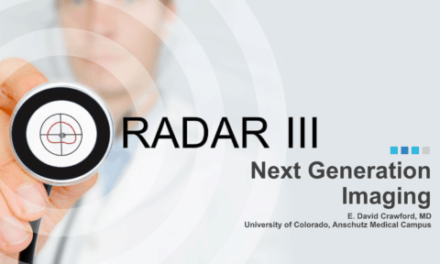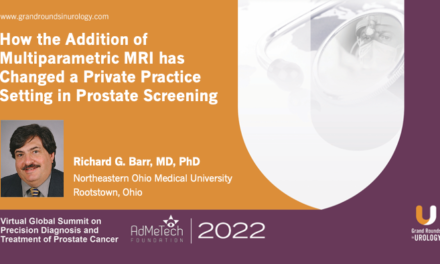3DBiopsy™ Transperineal Mapping Biopsy
How to cite: Stone, Nelson N. “3DBiopsy™ Transperineal Mapping Biopsy” April 12, 2018. Accessed [date today]. https://grandroundsinurology.com/3dbiopsy-transperineal-mapping-biopsy/
3DBiopsy™ Transperineal Mapping Biopsy – Summary:
Nelson N. Stone, MD, Founder and CEO/President of 3DBiopsy™, discusses how his comprehensive system aides in accurately identifying Gleason scores and guiding focal therapy. He and 3DBiopsy™ co-founders, E. David Crawford, MD, and M. Scott Lucia, MD, perform a demonstration as an illustration of the system’s needle, actuator, pathology carrier, and 3D mapping software.
3DBiopsy™ Needle and Actuator
Dr. Stone presents the 3DBiopsy™ adjustable needle with a rigged core bed and a four-point trocar tip, allowing for preserved specimen length as well as reduced needle deflection when firing into tissue. Also, a dial on the side of the actuator allows clinicians to set the intended length of penetration into the gland to any measurement between 20 and 60 millimeters.
Integrated Pathology System Specimen Carrier
Next, Dr. Lucia demonstrates transferring a 4.2 centimeter specimen from a sample prostate to the 3DBiopsy™ Integrated Pathology System (IPS). After gathering a specimen with the needle, he rolls the core bed against the IPS tissues. While the standard method of removing material from the core bed with forceps or a swab causes significant fragmentation, this specimen retained its shape, position, and a length of 4.1 centimeters upon transferal.
Additionally, the IPS lends itself to easy orientation identification, even when splitting the specimen in order to store it in a 3 centimeter processing cassette.
3D Mapping Software
Presently, 3DBiopsy™’s mapping software is under development. The software integrates with both ultrasound and MRI systems to create a “Virtual Prostate” in the operating room. This allows clinicians to plan the length, position, and orientation of sample sites. Furthermore, the software factors in patient information like age, race, prior biopsy, and Gleason scores to create an individualized model.
ABOUT THE AUTHOR
Nelson N. Stone, MD, is Professor of Urology, Radiation Oncology, and Oncological Sciences at the Icahn School of Medicine at Mount Sinai and chief medical officer at Viomerse, Inc.
Dr. Stone earned his medical degree from the University of Maryland in 1979. He completed a Residency in General Surgery in 1981 at the University of Maryland, followed by a Residency in Urology at the University of Maryland. He then completed a Fellowship in Urologic Oncology at Memorial Sloan-Kettering Cancer Center and a Research Fellowship in Biochemical Endocrinology at Rockefeller University in 1986. He was Chief of Urology at Elmhurst Hospital Queens from 1986-1996.
Dr. Stone has founded several medical companies and serves on the editorial board of many scientific journals. He is a member of many professional societies, including the Prostate Conditions Education Council, the Society for Minimally Invasive Therapy, the New York State Urological Society, the American Association of Clinical Urologists, and the American Urologic Association. Dr. Stone has participated in approximately 25 research studies on prostate cancer and has authored more than 500 articles, abstracts, and book chapters, primarily on prostate cancer. He invented the real-time technique for prostate brachytherapy in 1990 and has trained more than 5,000 physicians worldwide through his company ProSeed. His most recent company, Viomerse, creates synthetic body parts (phantoms) for surgical training and has recently released an extended reality remote training platform.



